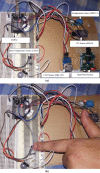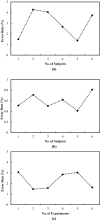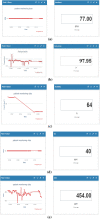Development of Smart Healthcare Monitoring System in IoT Environment
- PMID: 33063046
- PMCID: PMC7250268
- DOI: 10.1007/s42979-020-00195-y
Development of Smart Healthcare Monitoring System in IoT Environment
Abstract
Healthcare monitoring system in hospitals and many other health centers has experienced significant growth, and portable healthcare monitoring systems with emerging technologies are becoming of great concern to many countries worldwide nowadays. The advent of Internet of Things (IoT) technologies facilitates the progress of healthcare from face-to-face consulting to telemedicine. This paper proposes a smart healthcare system in IoT environment that can monitor a patient's basic health signs as well as the room condition where the patients are now in real-time. In this system, five sensors are used to capture the data from hospital environment named heart beat sensor, body temperature sensor, room temperature sensor, CO sensor, and CO2 sensor. The error percentage of the developed scheme is within a certain limit (< 5%) for each case. The condition of the patients is conveyed via a portal to medical staff, where they can process and analyze the current situation of the patients. The developed prototype is well suited for healthcare monitoring that is proved by the effectiveness of the system.
Keywords: ESP32; Healthcare monitoring system; Internet of things; Sensors.
© Springer Nature Singapore Pte Ltd 2020.
Conflict of interest statement
Conflict of interestOn behalf of all authors, the corresponding author states that there is no conflict of interest.
Figures






References
-
- Rahaman A, Islam M, Islam M, Sadi M, Nooruddin S. Developing IoT based smart health monitoring systems: a review. Rev Intell Artif. 2019;33:435–440. doi: 10.18280/ria.330605. - DOI
-
- Riazul Islam SM, Kwak Daehan, Humaun Kabir M, Hossain M, Kwak Kyung-Sup. The Internet of Things for health care: a comprehensive survey. IEEE Access. 2015;3:678–708. doi: 10.1109/ACCESS.2015.2437951. - DOI
-
- Lin T, Rivano H, Le Mouel F. A survey of smart parking solutions. IEEE Trans Intell Transp Syst. 2017;18:3229–3253. doi: 10.1109/TITS.2017.2685143. - DOI
-
- Al-Ali AR, Zualkernan IA, Rashid M, Gupta R, Alikarar M. A smart home energy management system using IoT and big data analytics approach. IEEE Trans Consum Electron. 2017 doi: 10.1109/TCE.2017.015014. - DOI
-
- Zanella A, Bui N, Castellani A, Vangelista L, Zorzi M. Internet of Things for smart cities. IEEE Internet Things J. 2014;1:22–32. doi: 10.1109/JIOT.2014.2306328. - DOI
LinkOut - more resources
Full Text Sources
Other Literature Sources
